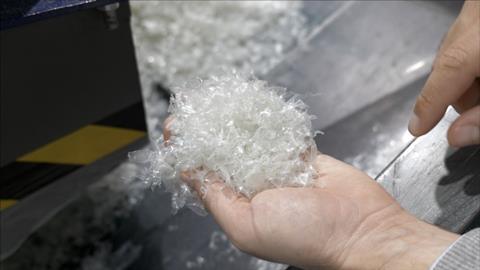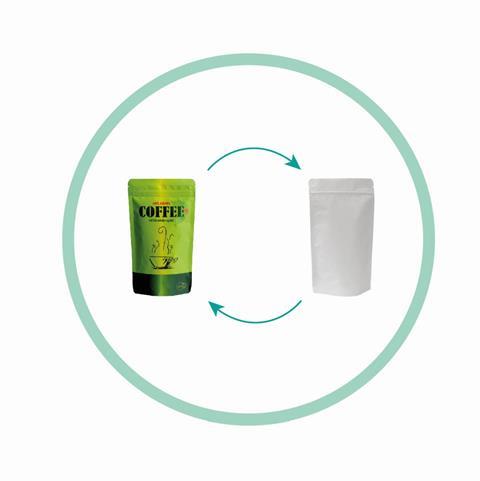Elisabeth Skoda takes a closer look at technology developments and innovations in the area of deinking and explores the role these can play in closing the loop and creating a fully circular economy.

Inks make up a small portion of packaging percentage-wise, but play a big role in packaging functionality, informing consumers about the contents of the packaging and promoting the packaged product on the shelf. However, inks can become a challenge when it comes to packaging recyclability, as they need to be removed to obtain clean, pure recyclate that can be given a second life.
Here deinking comes into play. The technology of removing inks from packaging has been used in paper recycling for several decades. More recently, the focus has extended to plastics. Advances in ink and deinking technologies can play an important part in closing the loop and producing better quality recyclate that can be used again in packaging rather than being downcycled.
A closer look at deinking technology
First of all, it’s important to define what we are talking about and clarify what deinking actually is, and Stefan Häp, Head of Technology and Innovation Brand Owner Collaboration at Siegwerk Druckfarben AG tells us more.

“Deinking is a hot washing process, typically using a caustic aqueous solution with detergent. The printed packaging material that has been cut into smaller pieces is put in this washing solution and stirred. This removes the ink layers from the plastic material. The ink that is washed off builds small flakes, and the coarser plastic material can be easily separated with a sieve. This plastic material is taken out and rinsed, and, cleaned from any ink residue, can then be re-extruded to high-quality recyclate that can be used again in packaging. The smaller ink residue particles can be filtered off.”
He goes on to explain that this part of the mix needs to be disposed of. The wash solution itself can be reconditioned for another wash step if it is clean enough. When there is a certain level of contamination, the wash solution also has to be disposed of.
“The target is that the wash water stays in a good shape, that the ink particles can be filtered off, and especially that the plastic material is recovered in a clean, clear state to be recycled and re-extruded.”
The right inks to facilitate deinking
This process works well for surface printed packaging materials such as shrink sleeves or labels. However, the challenge remains, as Mr. Häp points out, that the majority of flexible packaging material is not surface printed, but laminated.
“UV flexo inks and two-component or cross-linking coatings cannot be deinked well. On top of that, you have to make sure you don’t use pigments with a bleeding tendency. Some of the pigments typically used in food packaging applications are not always sufficiently resistant against alkaline conditions. They start to bleed and to discolour the wash water. To address that, Siegwerk offers deinking primers that can also make these highly resistant ink layers easier to wash off,” says Mr. Häp.
Before deinking a laminated material, it has to be opened up. Siegwerk has found a solution to make its inks more easily deinkable.
“Under lab conditions, we were able to prove that proprietary Siegwerk technology can make laminate open up under typical hotwashing conditions, which means that the inks and adhesives can be washed off so that the plastic material can be recovered.”
In the context of this, it is important to make sure that deinking does not compromise any other packaging specifications.
“Bond strength levels have to be maintained so that no delamination occurs during the packaging process or while a pack is used. To ensure that, an additional layer, a so-called delamination primer is inserted. As soon as the plastic material is placed in this hotwashing bath, the deinking primers dissolve and release all the inks and layers that can disturb the recycling process,” explains Mr. Häp.
The challenges of developing a deinking line

Arthur Lepage
Flexible plastics are traditionally the hardest to recycle of all packaging materials. Reborn Group, a plastics recycler and converter, recently opened the first plastic film de-inking line in France, which it says will make it possible to recycle printed films in industrial quantity. The company has set itself ambitious targets in terms of waste volumes treated.
“Our B.Clear deinking process is a mechanical recycling process during which the plastic film’s ink printed surface (around 1-micron layer of inks) is removed in washing units – after grinding and before drying and pelletizing,” says Arthur Lepage, Director of Reborn France.
“This new line enables us to upcycle printed film by removing the inks and producing clear pellets out of printed film waste. It opens up a vast array of film applications using clear pellets whereas recycled pellets without deinking are black or strongly coloured, hence ending up in low-cost applications such as refuse bags. We target a pool of waste estimated at a minimum of 100,000t in Europe. Reborn will launch another line by Q1 2023 and a third one is planned in Q1 2025 across our four manufacturing sites in France.”
Scaling up to industrial volumes from pilots and lab tests needed a lot of investment and R&D work, as did addressing the challenge of special water treatments used to deink.
“We started the project ten years ago and tested many different deinking processes. We overcame the main challenges with our work at a start-up in Spain and our knowledge in mechanical film recycling. Besides the capabilities of the equipment, we invested more than 1m€ in R&D to reach industrial status,” says Mr. Lepage.
He sees no obstacles in deinking different types of inks available on the market, whether it’s solvent-based, water-based or digital inks, but also highlights the challenge of laminated films.

“We can deink any film with surface printed inks and all types of inks are removed during the process. We can’t currently deink coloured film extruded with inks and laminated films with inks in between the layers. So the main hurdle now is to deink laminated films mostly found in food primary packaging. Our R&D efforts are now focused on deinking PET/PE or PE/PE structures with ink between the two layers.”
Collaboration across the value chain
As is so often the case when it comes to sustainability issues in the packaging industry, bringing all the relevant stakeholders is important, but also challenging. Brand owners can play a big role to boost progress in deinking technologies, as Mr. Häp points out.
“Packaging is not deinkable by default, so brand owners have to consciously make that decision. The benefit for them is that they can get clean recyclate that they can reuse to make new packaging, which will be extra important in the context of rising EPR fees and plastic taxes and will help them to fulfil their sustainability goals.”

Another crucial question is how the recycling industry can deal with deinking, and relevant organisations should agree on corresponding process conditions for deinking.
“Currently I’m only aware of one set of deinking process conditions by the US-based APR (Association of Plastic Recyclers). They have a defined deinking process for polyester beverage bottle to bottle recycling. But for flexibles, no set deinking process has been defined so far. We need the associations to jump in to pick up the deinking topic and make it more binding to their members and recyclers.”
Furthermore, Mr. Häp is keen to point out that sorters need to find a way to differentiate between deinkable and non-deinkable packaging.
“Projects such as Holy Grail can really help to make sure that only packs that are clearly defined as deinkable actually end up in the deinking stream.”
In the context of all of this, brand owners hold the key.
“The brand owners have to turn the lever and make the decision to increase the recyclability of all packaging by implementing deinkable structures, and once the volume and demand are there, recyclers will respond and expand capacity.”
Looking to the future
Where does all this leave us, and what is the outlook for deinking playing an increasingly big role in plastic packaging recycling?
Regulatory pressure is set to increase, at least in Europe, and in turn, it will become mandatory for the packaging industry to make use of recycled materials to a higher extent. Then, using recyclate will also be the most economical way for brand owners to keep the packaging cost low.
“At that point, brand owners will start checking what kind of technology is available to offer high volumes of sufficiently clean recycled material, says Mr. Häp.
Despite innovations in different recycling technologies such as solvent or chemical recycling, where it will be interesting to see how they develop, he thinks that mechanical recycling, as the established process in the Western world for packaging material, is an important cornerstone.
“Mechanical recycling already has a broad implementation level and is an economical way to recycle. It can benefit from deinking now as it makes the recyclate coming out of the mechanical recycling much more valuable for the industry. This allows stopping downcycling to the high extent we do today, as a lot of plastic material ends up in flower pots, for example. Recycled materials can become packaging again. For me, this is real circularity, and deinking can play a major role in this.”












No comments yet